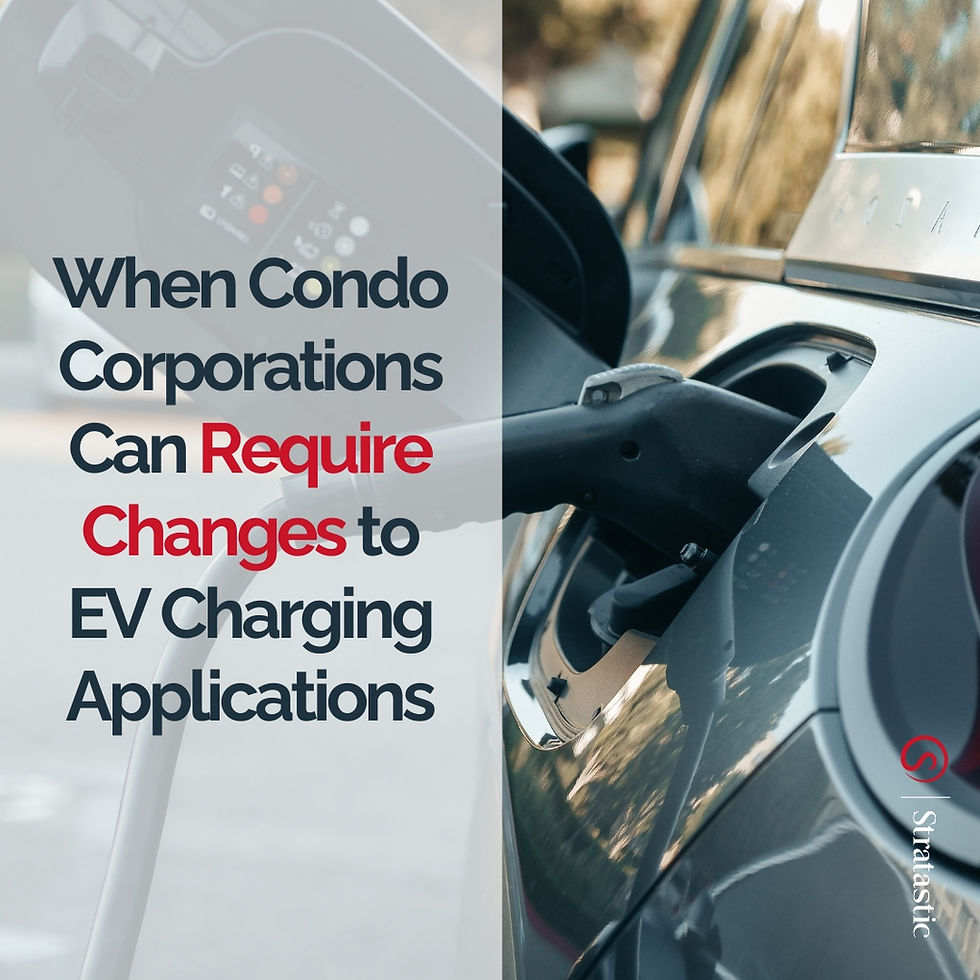
As electric vehicle (EV) adoption grows, many condominium owners are seeking to install EV chargers in their units or communal spaces. However, the installation of these chargers must be carefully managed to ensure safety, practicality, and compliance with regulations. One critical area for condominium boards and property managers is understanding when and how they can require changes to an individual unit owner’s EV charging application.
This blog will dive into the circumstances under which condo corporations can ask for modifications to a unit owner’s charging plan and the steps to take to ensure a smooth, compliant process.
When Condo Corporations Can Require Changes to Electric Vehicle Charging Applications
Regulatory Background
The 2018 Ontario regulations for electric vehicle charging in condominiums marked a significant shift in how these requests are handled. Before the regulations, condo boards had considerable discretion in approving or rejecting applications. Now, the regulations are designed to favor approval and limit board authority to deny applications unless there are valid safety or legal concerns.
While the regulations have streamlined the process for approving charging stations, they also provide guidelines for when a condominium corporation can require changes to an application. The rules are clear: a condo board can require changes to an application if the proposed installation interferes with the enjoyment of the property by other residents or if the installation does not align with the condo’s governing documents.
Interference with Other Residents’ Use and Enjoyment of the Property
One of the most common reasons a condo board may request changes to an application is when the proposed charging installation interferes with other residents' access or enjoyment of common areas.
A real-world example highlights how condo corporations can require changes. In this case, a condominium corporation received an application from a unit owner who wanted to install a charging node on a pillar in the underground garage. However, the location proposed would have led the cable connecting the charger to the car to block a pedestrian walkway.

Recognizing the safety risk and the need for accessible pathways, the condominium corporation decided that the charging station could not be installed in that position. Instead, the unit owner was asked to relocate the charging station to a different spot in their parking space, ensuring that the cable would not obstruct the walkway. This was a straightforward case where the condo corporation approved the installation but required a simple change in location for the safety and convenience of all residents.
Deviation from Governing Documents
Condominiums typically have rules and regulations in place regarding the use of common areas, construction modifications, and installations within individual units. If an owner’s EV charging proposal deviates from these rules, the condo board can require adjustments.
For instance, the condominium’s bylaws may specify where installations can or cannot occur within parking spaces. If an owner’s plan violates these stipulations (e.g., placing the charger too close to another unit’s space or using materials not authorized in the building), the board has the authority to request changes to the method or location of installation.
This ensures that the building remains compliant with its governing documents and maintains a cohesive, well-organized infrastructure for all residents.
Cost Considerations
When requiring changes, condo boards must also ensure that the modifications do not result in unreasonable additional costs to the installation. If the owner’s proposed changes are modest and do not significantly alter the overall cost of installation, the board can ask for these adjustments without burdening the owner financially.
However, if the proposed changes would add significant costs, the board must carefully weigh the necessity of the modification and consult with the owner about potential cost-sharing or alternative solutions that would minimize financial impact.
How to Handle the Request for Changes
When requiring changes to an EV charging application, it’s important for condo boards to approach the situation with transparency and clear communication. Here are a few steps to follow:
Provide a Clear Explanation: The board must explain why the changes are necessary and how they will address specific concerns (e.g., safety, compliance with bylaws, or minimizing interference with others).
Offer Alternatives: Rather than simply rejecting the original plan, the board should suggest viable alternatives that still meet the owner’s needs while addressing the concerns.
Documentation: Keep a record of all communications and decisions, and ensure that any required changes are clearly stated in the formal agreement between the unit owner and the condominium corporation.
Timely Response: Condo boards must respond within the 60-day period set out in the regulations. This ensures that the process moves forward efficiently and that the owner is not left waiting unnecessarily.
Further Resources: Changes in EV Charging Applications in Condos
Our blog also offers a wealth of information on relevant condo law topics, making it a valuable resource for property managers and boards alike. Or, explore Stak’d, our library with over 10,000 hand-curated condo-related resources for additional summaries and tools, or dive deeper into our blog for more detailed discussions on topics that matter to you and your community.
Changes to EV Charging Applications

The best way to handle requests for changes to EV charging applications is to be proactive. By developing clear policies and pre-approved installation specifications, condo corporations can reduce the likelihood of requests for changes in the first place. When these situations do arise, a transparent and fair process will ensure that both the condominium corporation and unit owners are satisfied with the final outcome.
In the end, the key to success lies in maintaining a balance: embracing innovation and progress with electric vehicles, while ensuring that the property’s rules and the residents’ needs are always prioritized.
-Stratastic Inc.
Need a legal perspective on EV Charging? Find condo lawyers on our vendor directory, My Condo Vendor.
P.S. Subscribe now for more insights like these, into all things Condoland!

Comentários